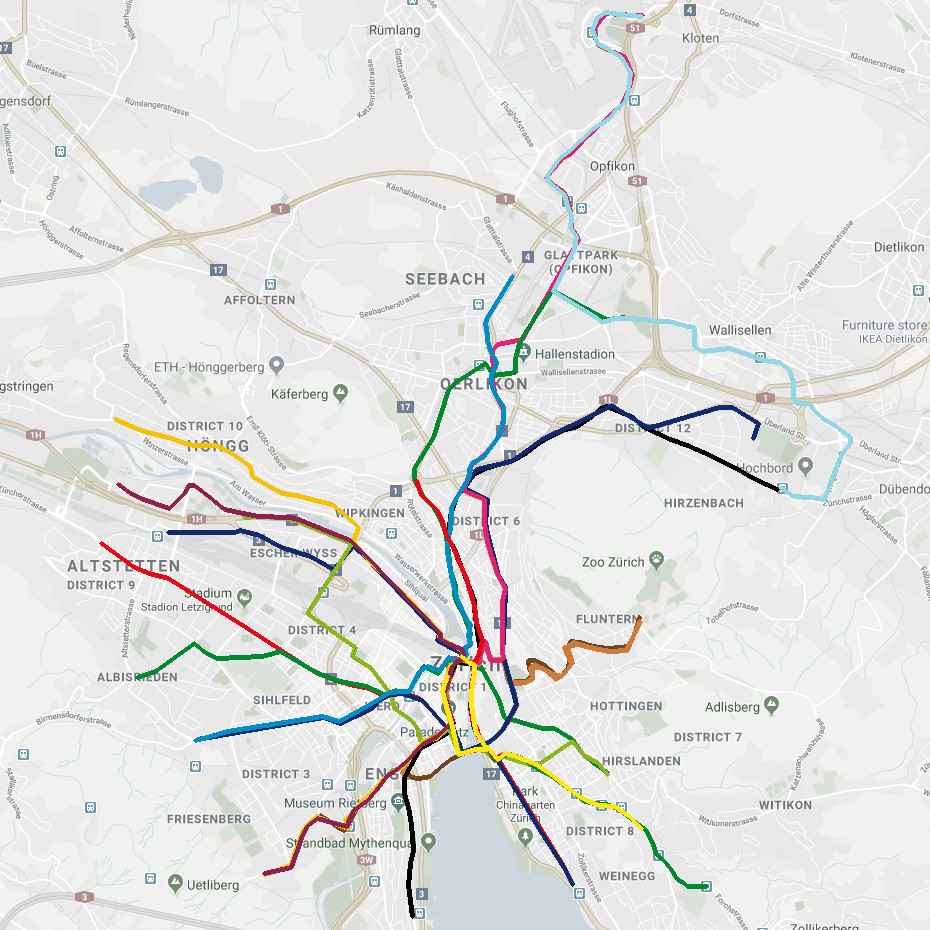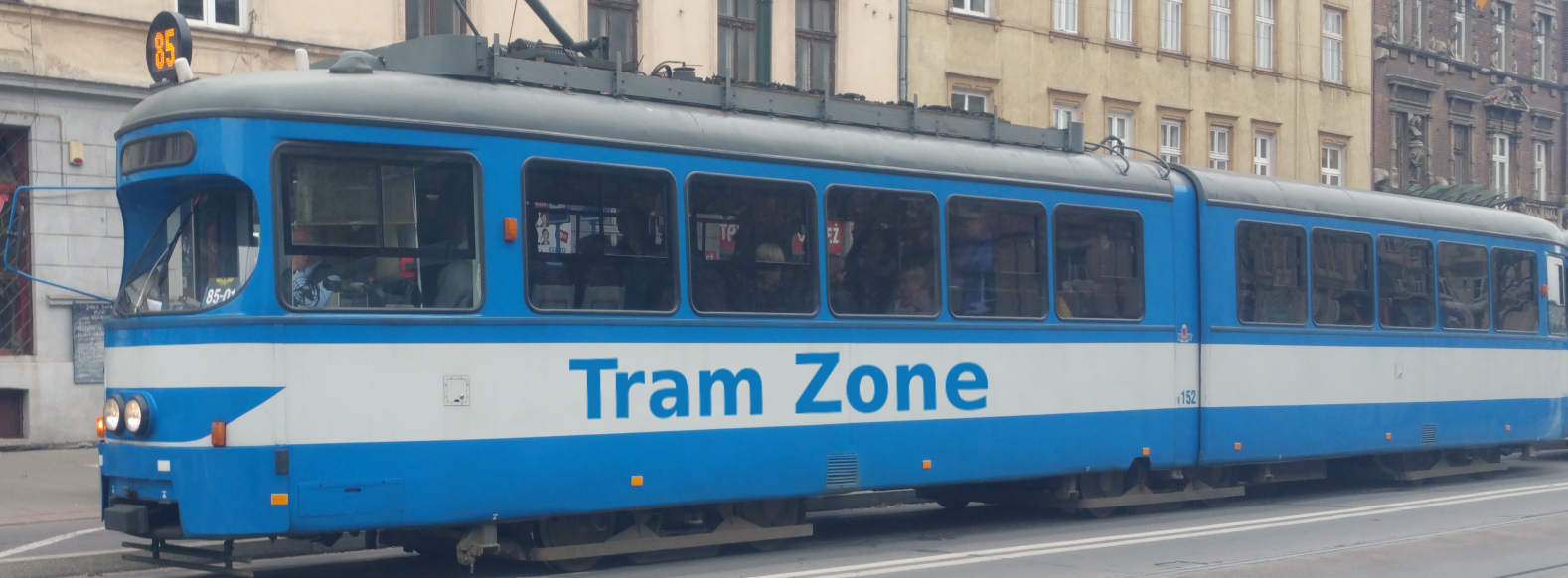Tram systems in Zürich
Zürich is Switzerland's largest city and the capital of Kanton Zürich and is situated at the northwestern end of Lake Zürich (Zürisee in the local dialect) in the central north of Switzerland. The municipality has a population of just over 400,000 inhabitants and is a major hub for road, rail and air travel. Zurich's main railway station (Zürich Hauptbahnhoff or HB for short) and airport are the largest and busiest in the country.
The public transport system within Zürich is overseen by the cantonal public transport authority Zürcher Verkehrsverbund (ZVV) extremely efficient, well-developed and well funded. The system has some of the highest frequencies of traffic in the world, with many routes served every seven minutes at peak times. The public transport system is extremely popular in Zürich, both with local residents and the many tourists that visit the city throughout the year. The transport system is comprised not only of the trams that this site focuses on, but also by local trains (the S-Bahn), diesel buses and electric trolley buses. The network also includes boats on the lake and the Limmat river, funicular railways and the Luftseilbahn Adliswil-Felsenegg, a cable car that runs between Adliswil and Felsenegg. The city has an integrated fare network and you can purchase one ticket for your journey and use any of the available transport methods.
Zürich's modern day trams are operated by the Verkehrsbetriebe Zürich (VBZ), which is wholly owned by the city and also manages the infrastructure of the tramways within the city. The ZVV's tracks are used by two other operators though. The Verkehrsbetriebe Glattal (VBG) are the main bus operator of the northern suburbs of Zürich and are also the owners of the infrastructure of the Glattalbahn tramway, although the trams on it are operated by the ZVV as a sub-contractor to the VBG. Additionally, the independent Forchbahn (FB) light railway which runs from Stadelhofen railway station via Forch to Esslingen makes use of the tram lines from its terminus at Stadelhofen to the outer suburb of Rehalp, from where it continues on its own lines.
Zürich currently has 16 tram lines, details of which can be found on the Lines tab
As far back as the 1860s, proposals were made for the introduction of trams to Zürich, but it wasn't until 1882 that the first trams actually started operating in the city. Since then, there have been a number of different companies operating lines within the Zürich area, the majority of which have either merged with other companies or closed down, until the present day situation. This section gives a chronological summary of the different companies and the areas they covered.
- Zürcher Strassenbahn Gesellschaft (ZStG) - This is the private company that opened Zürich's first private tramway in 1882, using horse-drawn standard gauge trams (1,435 mm or 4 ft 8½ in gauge). It was absorbed into the StStZ in 1897.
- Elektrische Strassenbahn Zürich (EStZ) - This company was the first electric tram operator starting in 1894, and also the first to use metre gauge (3 ft 3⅜ in gauge). It was bought by the city of Zürich and renamed as the StStZ in 1896.
- Zentrale Zürichbergbahn (ZZB) - Formed in 1895, the ZZB operated 2 lines, running from near the current Kunsthaus to the Kirche Fluntern and the lower terminus of the Rigiblick funicular. They also ran their trams to Paradeplatz on STSTz lines and were eventually acquired by the StStZ in 1905.
- Städtische Strassenbahn Zürich (StStZ) - The StStZ was formed by the city of Zürich in 1896 to buy the EStZ and continued to absorb other local operators until by 1931, it owned all the remaining private tramways in the city. In 1950, the StSTZ was renamed as the VBZ.
- Strassenbahn Zürich-Oerlikon-Seebach (ZOS) - Formed in 1897, the ZOS ran a tram route from what was Leonhardsplatz (now called Central) to Oerlikon and Seebach via Stampfenbachstrasse and Schaffhauserstrasse. The company later extended its route from Seebach to Glattbrugg and introduced a route from Oerlikon to Schwamendingen. ZOS operated independently of the city trams run by the StSTZ, until it was taken over by them in 1931. At the time of the take over, the Seebach to Glattbrugg and Oerlikon to Schwamendingen lines were closed.
- Industriequartier-Strassenbahn Zürich (IStB) - Formed in 1898, the IStB constructed a route from Bahnhofquai to Escher-Wyss-Platz, where it connected with the StZH route to Höngg. Initially. the trams ran through from Bahnhofquai to Höngg, however this through route ceased in 1901 and passengers needed to change trams at Escher-Wyss-Platz. IStB was taken over by StStZ in 1903 and the through route to Höngg resumed again.
- Strassenbahn Zürich–Höngg (StZH) - From 1898, the StZH ran a route from Escher-Wyss-Platz via Wipkingen to Höngg. At Escher-Wyss-Platz, the line connected with the IStB line to Bahnhofquai. The StSTZ aquired the company in three stages. First in 1907 when it purchased the section from Escher-Wyss-Platz to Wipkingen and replaced the bridge over the Limmat river. Then in 1931, the line as far as Höngg was purchased, followed in 1923 by the remainder of the line to the terminus at the Wartau depot.
- Dolderbahn (Db) - The Dolderbahn was opened in 1895 as a funicular running from Römerhof to the upper terminus at the Dolder Waldhaus Hotel. In 1899, a tramway was added to run from the upper terminus to the Dolder Grand Hotel. The line had a single car and was totally unconnected with any other tram line. The tram was replaced by a bus in 1930, which was itself replaced in 1973 when the Dolderbahn was converted to a rack railway and extended to the Dolder Grand.
- Limmattal Strassenbahn (LSB) - The LSB was formed in 1900 and ran an interurban line from the former Zürich city boundary at Letzigraben to Dietikon, via Altstetten and Schlieren. The company also ran a branch from Schlieren to Weiningen. The line connected to the StStZ at Letzigraben. The route between Schlieren and Dietikon was closed in 1928 and in 1931, the section between Schlieren and Weiningen was closed and the remaining section from Letzigraben to Schlieren was acquired by the StStZ.
- Bremgarten-Dietikon-Bahn (BD) - The BD was formed in 1902 and ran a rural tramway between Bremgarten in Kanton Aargau and Dietikon to the west of Zürich. The tramway was well outside of the city boundaries, but was indirectly connected to the city's tramways by the LSB at Dietikon. BD was amalgamated with the bus operator Wohlen–Meisterschwandento form the BDWM in 2000.
- Albisgütlibahn (AGB) - Formed in 1907, the AGB was the last privately owned tramway to be built within the city and connected the city tramway at Giesshübelstrasse to Albisgüetli, the site of the federal shooting festival. At the time, the location was very rural and after the festival finished, the line suffered from a lack of traffic, causing financial difficulties and in 1913, the company sold 3 of its 5 trams to the StStZ. By 1915, the line only operated on Sundays and was finally taken over by the StStZ in 1925.
- Wetzikon-Meilen-Bahn (WMB) - The WMB was a rural tramway, constructed in 1909, that ran from Kempten and Wetzikon to Meilen on the shores of Lake Zürich. The tramway was well outside of the city boundaries, but was indirectly connected to the city's tramways by the UOeb, with which it connected at Langholz, allowing connection to the FB.
- Uster-Oetwil-Bahn (UOeB) - Constructed in 1909, the UOeB was a rural tramway linking Uster, Esslingen, Oetwil am See and Langholz. The tramway was well outside of the city boundaries, but was indirectly connected to the city's tramways by the FB, with which it connected at Esslingen.
- Forchbahn (FB) - Constructed in 1912 and linking Zürich with the towns of Esslingen and Forch, the FB was initially a rural tramway that connected with the city trams at Rehalp and ran as far as the city centre. In the 1950s, the line was rebuilt with more railway characteristics and outside of the city runs separate from road traffic. The line continues to share the city tram lines from Rehalp to its terminus at Stadelhofen.
- Verkehrsbetriebe Zürich (VBZ) - The VBZ is the current tram operator in Zürich and was formed in 1950 when it was renamed from the StStZ.
- BDWM Transport AG (BDWM) - The BDWM was created in 2000 by the amalgamation of the BD with the bus operator WM. The company still operate a light rail service between Dietikon and Wohlen, but it is no longer connected to the city tram system.
Map of Zürich's current tram system

Zürich currently has 16 tram lines, which are listed below. To see more information about a particular line, click on the link in the table below (where applicable).
| Line | Descrption |
|---|---|
| 2 | Line 2 runs from Farbhof in the north west of Zürich to Bahnhof Tiefenbrunnen on the shore of Zürichsee to the southeast. |
| 3 | Line 3 runs from Albisreiden to the west of the city to Klusplatz in the south east. |
| 4 | Line 4 runs from Bahnhof Altstetten in the north west to Bahnhof Tiefenbrunnen. |
| 5 | Line 5 runs from Laubegg in the south west to Kirche Fluntern in the east of the city (and on some days on to Zoo). |
| 6 | Line 6 runs from Bahnhoff Enge to Zoo |
| 7 | Line 7 runs from Bahnhoff Stettbach in the far east of the system to Wollishofen in the far south. |
| 8 | Line 8 runs from Hardturm to Klusplatz. |
| 9 | Line 9 runs from Hirzenbach in the east of the city to Triemli in the west. |
| 10 | Line 10 runs from Hauptbahnhof to the airport, north of the city. |
| 11 | Line 11 runs from Rehalp in the far south east of the city to Auzelg in the north east. |
| 12 | Line 12 runs from Zürich Airport to Bahnhoff Stettbach and is the only line that does not go into the center of the city. |
| 13 | Line 13 runs from Frankental in the north west of the city to Albisgütli in the south west. |
| 14 | Line 14 runs from Triemli to Seebach in the north of the city. |
| 15 | Line 15 runs from Bucheggplatz to Bahnhof Stadelhofen. |
| 17 | Line 17 runs from Werdhölzli in the north west to Zürich HB (and in peak times to Albisgütli) |
| 21 | Line 21 is a heritage line run by Zürich Tram Museum from the city centre to the museum at Burgweis (and Rehalp on Saturdays). |
